Diy Arcade Cabinet Diy Easy Arcade Cabinet
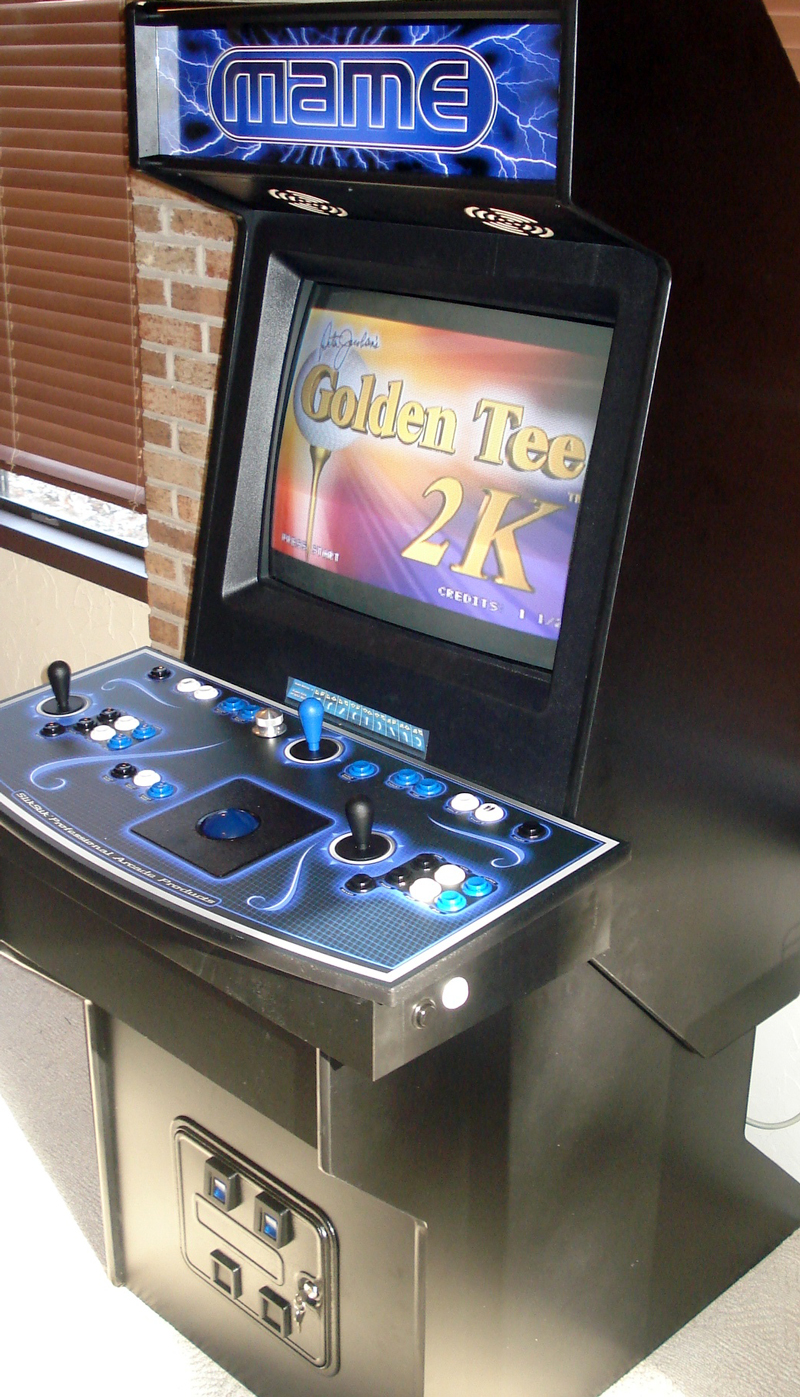
My Custom Built MAME Arcade Cabinet!
I wanted to build a home arcade machine that could play all the classic video games as well as those console favorites. I've played around with arcade emulators on my PC before so I knew a little bit about how it all worked. After months of researching and reading a lot of different websites, I came up with an economical plan that didn't require too much time and the end result was a highly polished professional arcade system.
In this article I outline every component that was purchased, how much was spent, and my reasoning behind each one. I only wish I had this information when I started to build my own arcade as the majority of it was scattered throughout websites and forums. This is why I'm posting this information so you can save a lot of time and money. There are many factors to consider–You could drop $3,000 and buy a complete arcade system that plays maybe 100 games, or you could assemble your own for about half the price and play thousands of games. The choice was an easy one for me.
1. Arcade Cabinet
The arcade machine all starts with an empty cabinet. You have some options to consider–buy a used arcade machine and gut it, buy cabinet pieces to assemble, or just buy the plans and start from scratch. I decided to go the easiest route that still gave me control over the components so I ordered pre-cut pieces. I'm no stranger to power tools, but I felt the time it would take didn't out way the costs of just buying the pieces and assembling.
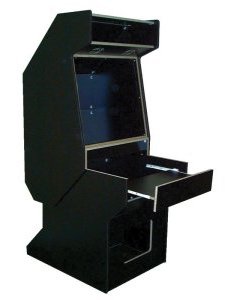
MameRoom DYI Cabinet Kit
$460 + $125 shipping
I ordered the do-it-yourself UAII cabinet kit from MameRoom Designs. The cabinet arrived in multiple boxes and were of good quality. All the parts were labeled with lettered stickers and the build instructions were easy to follow. It wasn't all puppy dogs and ice cream, as a lot of the pieces were damaged like they had been dropped. There were a couple pieces they forgot to send and a few were duplicates. I question their QA process, however, they were really good about it and immediately shipped new pieces.
Update: MameRoom Designs was purchased by another company since this article was published.
2. Arcade Controls
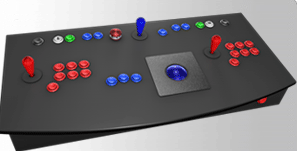
SlikStik Classic Unit – $500
You can build your own controls by ordering the individual buttons, trackball, spinner, wires, and what's called an I-PAC controller and plug it into your PC or you can order pre-built controls that fit cleanly into the cabinet and easily connect to your PC. Once again I'm no stranger to wiring things up, but I do have that full time job that cuts into my time and I actually wanted to complete this before winter.

Midnight Blue Overlay – $80
I ordered the Classic Unit panel and added the midnight blue overlay. I highly recommend an overlay as it makes the controls look like a real arcade system. The painful thing is it took almost 5 weeks from when I ordered to the day it was delivered. The construction and overall quality is superb and definitely worth the wait.
The Classic Unit has has a trackball, spinner, and 2 main joysticks. They have other models available with 4 player controls too. Installation is as easy as plugging 3 USB cables into your PC. One cable is keyboard output which maps the joysticks and most buttons to regular keys, and two mouse cables for trackball and spinner knob.
Update: SlikStik has gone out of business since publishing this article
3. 27" Television
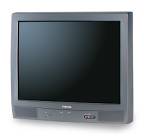
Toshiba 27″ TV
I bought a 27" Toshiba TV from a friend for $65 after spending weeks searching craigslist for one that had power-return. This feature isn't something you hear much about but is important for a game cabinet. It means if power goes out, it will turn itself back on and to the correct channel. The reason you need this is you won't have easy access to the power button and the bezel will cover the IR port so the remote won't work either. The model I got also had S-Video and a high comb filter which displays graphics and text cleanly at 800×600 resolution. All the classic games look great on it.
4. PC – Dell 2.4 Ghz
This was my old PC and I put a fresh install of Windows XP Home Edition on it and used an old graphics card–the ATI all-in-wonder w/ S-Video out. I tried using a newer nVidia GeForce 4 card but the S-Video on it was horrible and after reading that other people had similar issues I would suggest sticking with ATI if your buying a new card.
One thing to note is a high-end graphics card isn't really needed as emulators use more CPU than anything else. I'd suggest going middle of the road for both your graphics card and CPU. It doesn't take much to power these retro games from 1980.
Update: If you don't have an old PC to use then you might consider buying a Raspberry Pi 2 which costs much less than a PC and is powerful enough to run arcade emulators.
5. Lighted Marquee

Mame Marquee – $20
The marquee was bought from Mame Marquee and featuring an awesome blue lightning effect. I think it really looks sharp and matches the midnight blue overlay on the control panel.
The Fluorescent Light Fixture was purchased from Happ Controls. It didn't come with a plug so I had to take an old extension cord and splice it together.

Fluorescent Light Fixture – $10
Happ Controls
Plexiglas – $8
Local Hardware Store
Finally I bought two pieces of clear Plexiglas cut to fit from my local hardware store, sandwiched the Marquee in between the two pieces, and installed the light fixture behind it. The lightning bolts coming out of the Mame logo look awesome when lighted.
Update: Mame Marquee website is no longer available and Happ Controls has become Suzo-Happ.
6. Monitor Bezel
Ordered the 27" Monitor bezel from Happ Controls and used a utility knife to trim to fit. This hides everything on the TV except the screen. I got lucky in that it fit perfectly against the screen and the T-molding held it in place without Velcro or tape.
7. Sound
I used a sub-woofer I already had and bought Cyber Acoustic Speakers to mount above the pre-cut speaker holes. Keep in mind that your arcade can also double as a jukebox, so make sure you get something that sounds decent.
I removed the screens from these speakers which revealed 6 empty holes. I took a couple screws and put them halfway into the cabinet and then slide the speakers onto the screws. It held pretty good by itself, but I also reinforced it with some good old duct tape.
8. Smart Power Strip
This is a really slick power strip that allows you to have one device be the control power for numerous other devices. For example, my PC is the control so if I power it up then the strip powers on the other devices which include the TV, marquee lights, and sound.
If I shutdown the PC then all the other devices will also shutdown. I can access the PC's power button by opening the coin door.
9. Coin Door
The coin door was the last touch to the arcade which is just for looks and has no real function. The arcade games do require a coin to be inserted prior to playing. However, the control panel has coin buttons to trigger this event.
The door was ordered from Happ Controls and came with yellow coin reject buttons. You can save money by not ordering the entire coin door system as the UAII plans state, but instead just get what you see from the outside. I have listed this part number on the right and it's all you need.
The coin door comes with yellow buttons installed which didn't fit my color scheme so I ordered blue buttons and swapped them out. I took an old power supply and wired up the included 14V light bulbs. It was a nice final touch to the arcade.
10. Game Emulators
Emulators are needed to drive your arcade games which are called ROMs. Your PC is way more powerful than the original hardware that ran all those classic games and there is a whole community dedicated towards writing emulators to play them. There are many emulators out there and what follows are my favorites:
The MAME (Multiple Arcade Machine Emulator) software is probably the best known emulator in the world and plays the majority of your classic arcade games. If your running Windows, you'll want to use Mame32 which gives a nice GUI around the MAME engine. You'll need MAME to run games like Pac-Man, Joust, Asteroids, Donkey Kong, Golden Tee, and about 3,000 more.
SNES has numerous emulators and I found Nestopia to be the easiest to get up and running. Super Mario Brothers and Zelda are games you just have to play.

Kega Fusion Sega Emulator – Free!
Fushion
The Sega Genesis has a great emulator called Fusion. The fast paced Sonic the Hedgehog makes it a requirement to download.

Stella Atari 2600 Emulator – Free!
Stella
The Atari 2600 can be played using the Stella emulator. This console was introduced in 1977 and the games were very simple. If you remember Combat, Pitfall, and Kaboom! then you have to get it.
Daphne is an emulator that plays those classic arcade laser disc games. As a kid I remember watching others play Dragon's Lair but I never did because it was too expensive. Now you can play as much as you like without a bankroll of quarters.
The ROMs (games) are very easy to find by searching Google, but remember most of them are copyright so you'll need to check if your legally allowed to run them. 😉
The hardest thing to find were the laserdisc's for Daphne. You can buy them online or use bittorrent to download the MPEG files.
Update: Mame32 emulator was renamed to MameUI.
11. Front Loader
I wanted my arcade system to look like a real arcade system and not a Windows PC. This requires removing the Windows boot-up screen, login screen, mouse cursors, and background colors. It is actually possible to customize it so there is no trace of Windows. The best resource I found for doing all of this can be found here: Wiki – Hiding Windows.
The arcade should be configured to boot directly into what's called a front loader. Front loaders provide an easy way to select an emulator and game to play without ever seeing Windows Explorer. There are many front loaders out there, some free, some cost a few bucks, and after trying almost 20 different ones I decided on Maximus Arcade. It is very easy to configure and navigate games with a joystick or trackball. It also includes a MP3 player jukebox which is a nice feature.
The best free front loader I found was AtomicFE. Another good front loader to check out is GameEx which is far more extensive than all others but looked too much like Windows Media Center for my taste.
My Dream Arcade Machine
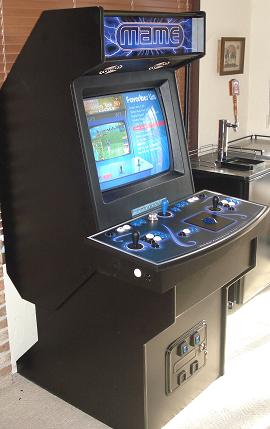 I have over 7,000 different games available on my arcade system. I use the favorites menu to keep track of the ones my friends and I play the most. If I had to create a most played list it would include:
I have over 7,000 different games available on my arcade system. I use the favorites menu to keep track of the ones my friends and I play the most. If I had to create a most played list it would include:
1. Golden Tee 2k
2. Berzerk
3. Track and Field
4. Hyper Sports
5. Missile Commander
6. Galaga
7. Dragon's Lair
8. Asteroids
9. Defender
10. Super Mario Brothers 1 and 3
11. Zelda
12. Joust
13. Q-Bert
14. Pac Man
15. Ms. Pac Man
16. Centipede
17. Street Fighter 2
18. Mortal Kombat 3
19. Dig Dug
20. NBA Jam
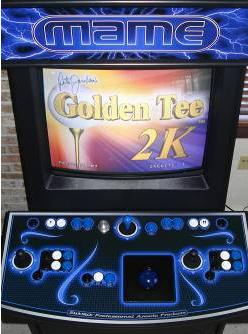 It's been a lot of fun discovering coin-operated arcade games that I played as a kid and competing with my friends for the highest score. Now that it's in my bar room next to the kegulator there has been many late nights of drinking, gaming, and tough talk.
It's been a lot of fun discovering coin-operated arcade games that I played as a kid and competing with my friends for the highest score. Now that it's in my bar room next to the kegulator there has been many late nights of drinking, gaming, and tough talk.
Although this project has been completed, something tells me I'll be tweaking it for years to come.
I highly recommend building your own arcade system. The process of building it was almost as fun as playing the games themselves. Almost. 🙂
If you don't want to build your own arcade you have other options such as mini-arcades and arcade controllers for your pc/television. Check out these great products on Amazon:




NOTE: I do not recommend X-Arcade because of shady business practices. I previous signed up with their affiliate program and after sending them a ton of traffic over 6 months they suspiciously shut down the program without any notice or payment. That's just bad business!
Source: https://toddmoore.com/arcade/
0 Response to "Diy Arcade Cabinet Diy Easy Arcade Cabinet"
Post a Comment